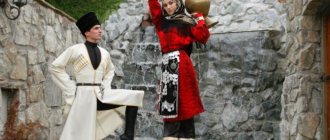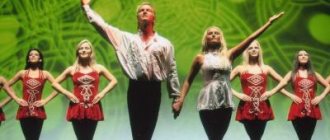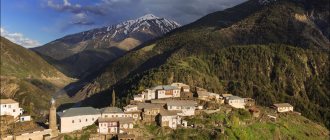The Lezgins belong to one of the most ancient peoples of the Caucasus, who managed to create an original tribe from a small community, which later became an independent ethnic group. In the traditions of the Lezgins, the culture of these people is clearly manifested - it preserves ancient elements that, gradually transforming, harmoniously fit into modern realities.
Despite this “plasticity,” the Lezgins faithfully preserve the heritage of their ancestors. Today, most of this people live in Russia, Southern Dagestan and Northern Azerbaijan, where Lezgin communities have preserved the ethnic characteristics of their people. What do Lezgin customs mean? What do Lezgins believe? How are their traditional holidays held?
Where live
The people live in the Russian Federation in the south of Dagestan and in the north of Azerbaijan. In Dagestan, Lezgins inhabit the Derbent, Akhtyn, Kurakh, Dokuzparinsky, Suleiman-Stalsky, Magaramkent and Khiva regions.
In Azerbaijan, these people live in Kursar, Khachmas, Kuba, Gabala, Oguz, Ismayilli, Sheki, Kakh regions and all major cities, especially in Baku. Experts from the Institute of Anthropology and Ethnology of the Russian Academy of Sciences believe that there are more Lezgins on the territory of Azerbaijan, but some of them are recorded as Azerbaijanis.
Spiritual heritage or what is the national religion of the Lezgins?
What can be said about the spiritual heritage of the ancient Lezgins? Today, most of this ethnic group practices Islam. Scientists readily admit that the religious culture of the people has not been sufficiently studied, but its roots, of course, go back to paganism and are largely intertwined with popular mythology. For example, Lezgins still have a rather curious idea of how the unusual planet Earth is located in space. It is believed that it rests on the horns of Yaru Yatsa (Red Bull), who, in turn, stands on Chiehi Yad (translated as “Big Water”). Here's a pretty cool design. Although this is somewhat contrary to scientific evidence, some sincerely believe it. These were unusual ideas about the world that Lezgins had. The nationality that professes Islam is very unique.
Name
The origin of the ethnonym “Lezgins” has not yet been fully studied and requires additional research. Authors of ancient times called Lezgins “leki”, Arab authors called them “lakz”, Georgian authors called them “lekebi”.
In written sources, the term “Lezgi” has been known since the 12th century. But this word was not used to call a separate Dagestan people. This term was unfamiliar to the Dagestan highlanders. The Turks and residents of Tsarist Russia called Lezgins the numerous mountain tribes that inhabited the Dagestan region and part of the southern slope of the Main Caucasus Range. The Russians called the southern Dagestanis that way, and the northern ones, mostly Avars, were called Tavlinians. The term began to be used for Lezgins in the late 19th and early 20th centuries. The ethnonym “Lezgins” became the name of one of the mountain peoples of Dagestan after 1920.
Nationality "Lezgins": history
A long time ago, several original mountain tribes united in order to create their own state, unlike anyone else, with its own spiritual culture and deep traditions. It was the beginning of the 13th century. Well, they succeeded very well, because today the Lezgins (nationality) live in the southernmost territories of Russia and the Republic of Azerbaijan. For a long time they inhabited the Dagestan region, which every now and then passed into the possession of new invaders. The inhabitants of that area at that time were called “emirs of Lezgistan.” Over time, the state split into many small khanates that fought for their independence.
Language
The Lezgin language is part of the Nakh-Dagestan group of the North Caucasian language family and belongs to the Lezgin subgroup. Russian and Azerbaijani are common among Lezgins. Lezgins living in Azerbaijan use the Azerbaijani script.
The Lezgin language is divided into adverbs:
- Samur, includes the Akhtyn dialect and the Dokuzparin transitional dialect;
- Kyurinsky, includes Yarkinsky, Güney, Kurakh dialects;
- Cuban.
There are also independent dialects in the Lezgin language:
- Giliyarskiy
- Kurush
- Gelkhensky
- Fian
The tsarist government in 1905 decided to facilitate the Russification of the people and tried to create Lezgin writing on the basis developed by Baron P. Uslar. But this attempt was unsuccessful. In 1928, the Latin alphabet was developed for the Lezgin language, and in 1938 a new alphabet based on the Cyrillic alphabet was created.
Ancient rituals and modern life
Lezginsky - what kind of nation is this? Let's take a closer look below. Despite their small numbers, the Lezgins have fairly basic moral standards associated with long-standing traditions.
Among wedding customs, one of the most unexpected can be distinguished: bride kidnapping. The most interesting thing is that this tradition was practiced both with and without the consent of the bride. As it turned out, there was no ransom as such. For a young woman, a certain payment was simply made to her parents. Perhaps today it is somewhat reminiscent of a purchase and does not seem entirely worthy, but practice shows that most local residents reacted to it with joy and great enthusiasm.
Life
The Lezgin family is large; it consists not only of husband, wife and children. It includes parents, minor sisters and brothers of both spouses, and widowed daughters-in-law. Some families consist of 17 people, but this is rare today.
Since ancient times, the main occupation of the people has been arable farming. Corn, wheat, millet, barley, legumes and rice were grown. The Lezgins, living on the plains, were mainly engaged in pasture-stall cattle breeding. In the mountains, cattle breeding was transhumance. They mainly raised sheep, goats, and cattle. Most of the winter pastures were located on the territory of Northern Azerbaijan. Traditional trades include spinning, production of cloth, felt, carpets, weaving, blacksmithing, leatherworking, jewelry and weapons.
Horror stories for kids
In the old days, Georgians scared children, saying that if they behaved badly, a Lezgin would come and take them away. But what is this strange confrontation between peoples? The fact is that in former times there were many mountain robbers among the Lezgins who could actually kidnap children or take away valuables.
It was probably this type of activity that led to the appearance of horror stories. What’s interesting is that today Lezgins and Georgians are tolerant of each other. Moreover, many Lezgins have Georgian relatives. As you understand, nowadays no one scares children with Lezgins.
Housing
The main type of settlement among Lezgins is called “khur”. Villages founded in the mountains are located mainly on slopes, close to sources of drinking water. The houses are closely located to each other. The village is divided into quarters, which one by one can sometimes form large territorially related settlements “tukhum”. Each village has a mosque and a village square "qim". On it, local residents, namely men, gather at a village gathering to discuss and resolve the most important issues of rural public life.
The oldest quarter is located in the upper part of the village and consists of old stone houses. These are real fortresses with a closed courtyard, loopholes and a small number of external fetters. There is usually no greenery here. The middle part of the mountain village is located on a less steep slope. The new neighborhoods are located on level ground and consist of larger courtyards, which are fenced off from the street by a clay or stone fence. Among the greenery in the courtyard there is a one-story house, which is built of stone or mud brick. The modern lower quarters contain schools, clubs and hospitals. In the mountain village of Akhty, residents have houses in the upper and lower quarters, with a garden. They live upstairs in the winter and move downstairs in the summer.
Lezgin houses are U- and L-shaped, or built in the shape of a closed square. To get into the two-story building from the street, you need to go into a small courtyard through an arch-shaped gate. In one of the corners of the courtyard there is an oven in which chureki flatbreads are baked. A staircase made of stone or wood from the courtyard leads to a gallery onto which the doors of all rooms of the dwelling open.
The walls and floors of a Lezgin house are always covered with rugs and carpets. One of the rooms has a fireplace in which food is prepared. Instead of windows, until the mid-19th century, houses had holes in the flat roof. Today the roof is still flat, but the windows have already been broken into the walls. They were also made in old houses. Since the middle of the 19th century, balconies began to be made in homes that overlook the street. In some mountain villages, related families living opposite create closed passages connecting the second floors.
After the wedding
After the celebrations are completed, the groom takes the young bride and goes with her to his parents' house.
The wedding night is a sacred sacrament, after which the groom's mother and aunts must receive visual confirmation of the bride's innocence. On the morning after the wedding night, the bride's parents were told that the girl was indeed chaste, and the celebration continued. Only on the third day did the now young wife leave the room and meet the guests on the threshold of her new relatives’ house. She gives each person a personalized gift. The groom spent the first two days after the wedding in the company of his friends, and on the third he met his close relatives and received congratulations.
Appearance
Lezgin clothing is similar to the costumes of other peoples of Dagestan. The man's clothing consists of a waist-length shirt with a lining made of calico, trousers made of dark material, wool socks, a beshmet, a Circassian coat and a hat. The costume is completed with a silver belt, gazyrs and a dagger. In winter, men wore fur coats.
Today, many men wear urban clothing. Elements of the national costume often include hats, woolen socks and sheepskin coats with fictitious long sleeves.
Women wore a long shirt in the form of a tunic with a stand-up collar and long sleeves. Wide trousers that tapered downward were worn with the shirt. The lower part of the trouser legs was visible from under the shirt; women decorated them with embroidered patterns and bright colored stripes of fabric. At the end of the 19th century, the bun dress appeared in the wardrobe of Lezgin women. Elderly women wore such dresses, sewn from dark-colored fabrics, while young women wore buns made from bright fabrics of green, red and yellow. The dresses were loose cut, each woman sewed them with her own hands. Women still wear national clothes today, especially in rural areas. Although many people are gradually acquiring urban clothing and shoes, the custom prohibiting showing oneself in public with one's head uncovered is still strictly observed.
Women's headdress - chutkha, is a cap that fits the head with a hair bag sewn to it. They wore Lezginkas and various scarves made of brocade, silk and wool. Elderly and married people wore scarves to cover part of their face and mouth. This was a mandatory rule.
Women wore a lot of jewelry, rings, earrings, bracelets. The outfits were decorated with silver coins. It was believed that the ringing of these coins repels bad things and attracts good things. The Lezgins considered silver a special metal that collects bad energy and self-cleanses itself from it.
The beauty of a woman of this people was determined by her slender figure, black eyebrows and eyes, and hair. Long thick hair braided in two braids was considered ideal. It was not customary to braid just one braid; it was believed that if a girl wore such a hairstyle, she would be alone forever. This hairstyle was especially prohibited for women who had brothers and fathers. Often, when Lezgin women quarreled with each other, they uttered the phrase: “So that you are left with one braid.”
Children under 3 years old were wearing amulets, amulets, coins and beads. Lezgins believed that they had magical powers and protected against the evil eye and disease. A hirigan bib was worn on children's jackets. On the back of jackets and sleeveless vests, the murtsan tsuk flower was sometimes embroidered, which consisted of 12 petals of different colors according to the number of months in the year. It was believed that the flower protected the child from misfortunes throughout the year.
How does matchmaking and engagement work?
Most often, boys and girls are engaged in early childhood, but if this happens at an adult age, then the bride is simply showered with expensive gifts. The main gift is a wedding ring made of silver or gold.
Betrothal is a ritual during which those accompanying the groom or his representatives come to the house of the bride's parents with gifts intended for the girl and refreshments for her parents and relatives. The parties previously agreed on the amount of the bride price, which had to be collected before the appointed date.
On the day of the engagement, the girl's father received numerous guests in his house. It could be the future groom himself or his father, uncle, brothers and closest relatives. The elder representatives of the clan could conclude an agreement. If the answer was positive, an expensive ring was put on the bride’s finger. From this moment until the wedding day it could take from a year to five or more years. During this time, the young people did not see each other and did not communicate. There have been cases when the bride and groom, engaged in infancy, knowing about each other’s existence, met for the first time only at their own wedding.
Food
The main traditional food of Lezgins consists of legumes, grains, dairy and meat products. Bread is baked from sour or unleavened dough in the form of flat cakes. A special oven is used for baking. In Dagestan, Lezgin thin bread is very popular. The “afarar” pies of this people, filled with cottage cheese, herbs and meat, are also very popular. Lezgins prepare soups with meat and potatoes “bozbash”, khinkal, shish kebab and cabbage rolls. The meat is used fresh and dried, popular meat dishes: fried meat “kabab”, gatay kabab, cutlets. Various dishes of Azerbaijani cuisine are also included in the people's diet. The drinks are made into tach, a drink similar to jelly made from sprouted wheat grains. The ritual food of Lezgins is a dish of dried lamb legs with grains of corn and wheat, flour porridge “Khashil” and halva made from wheat flour “Isida”. They drink fresh and sour milk, make cheese and butter, and cook porridge.
Wedding preparations
The girl’s parents begin preparing for the wedding almost from the moment she is born.
Such preparation consists of collecting a dowry, which consists of: dishes; bedding;
pillows and blankets;
fabrics;
clothes.
Wealthier Lezgins gave jewelry or silver dinner sets as a bride's dowry. Preparations for the wedding lasted several years, since it was necessary not only to sew festive clothes, but also to collect a dowry, gifts for dear guests and relatives of the groom.
Traditions
In every Lezgin family there is unquestioning obedience to elders. Old people are shown great respect. They are not allowed to do difficult work. Women's inequality used to exist. But modern women are already economically independent, since they work and have access to education and social activities. There are ancient traditions that do not allow a modern Lezgin woman to achieve equality with a man. In many families, women are still not allowed to eat with men in front of strangers, and men are ashamed to openly help a woman with work. But raising a hand against a woman or somehow insulting her dignity is considered a great disgrace not only for the man who did it, but also for his entire family.
The tradition of blood revenge among the Lezgins disappeared after the October Revolution, and villagers are increasingly helping not only their relatives, but also their neighbors.
Previously, women gave birth only at home and used magical remedies to facilitate childbirth. The man was not supposed to be in the house at these moments, and the one who informed him about the birth of a child first received a gift. If a girl was born, it was a less joyful event than the birth of a boy. On the first night after giving birth, the woman in labor was not supposed to sleep, but was obliged to protect the child from demons. In the courtyard, spirits were driven away by horses and gun shots.
The name of the newborn was given by one of the older relatives. On this day there was a holiday in the family, treats were prepared. To this day, the child is named after a deceased relative who lived a decent life. But if a child was capricious and sick for a long time, his name was sometimes changed. If a woman could not have children, she was sent to visit the sacred places of the Caucasus. Lezgins believe very strongly in the healing power of such places and take visiting them seriously.
The hair that was cut for the first time by a child was not thrown away and was protected. The first haircut was carried out by the man who was the eldest in the family. The hair was placed under the child's pillow so that he would have a healthy and sound sleep. To prevent the child from being a thief, his nails were not cut for a long time, and when this procedure was first carried out, the cut nails were burned.
It was considered a bad omen if the child's first tooth was discovered by the mother. If this happened, she tore the collar on her underwear so that the child’s teeth would grow well. The baby's shirt collar was also slightly torn. The first person who noticed the baby's tooth was given a needle - a symbol of sharpness.
Previously, Lezgins married distant relatives. Today this custom is gradually disappearing. In ancient times, the parents of the bride and groom agreed on the marriage of their children when they were still small. Sometimes the bride was stolen if she did not want to get married or the chosen one’s parents were against it. Before the wedding, matchmaking took place. A close relative of the groom came to the bride's house and proposed. If he gave his consent, the groom's relative sent the bride a ring, a scarf and a dish of pilaf. A few days later, the groom’s father and several men came to the bride’s house and brought a scarf and money, the parents agreed on the size of the bride price. From now on, the bride and groom were not supposed to meet.
The wedding began simultaneously in the houses of the bride and groom. When entering the groom's house, the bride must crush the spoon of butter that was placed on the threshold with her foot. Afterwards, the bride was led into a room and placed on a dowry chest. During the celebration, the bride sat silently. At midnight the groom came to her, and the women who surrounded the bride left. In the morning, the groom must go for a swim in the river and spend the whole day at a friend or relative's house. If the bride was not innocent, the groom could throw her out of the house and immediately divorce her. Often, after this, girls committed suicide. In the Samur district, during a divorce, the man's family had to pay the woman's family an amount of money for the maintenance of his ex-wife.
Today the Lezgin wedding is different. There is no more bride price and the mule no longer takes part, brides are not kidnapped, and parents do not agree on the future wedding of their still young children. The wedding ceremony has remained virtually unchanged, only in many villages the bride is carried not on a horse, but by car, and the dowry is transported in a truck.
Raising children occupies an important place in the life of the people. They began to train and raise them in the womb. Lezgins are hospitable and give their guests the best. The owners will give up the most comfortable and largest bed in the house to the guest, and they themselves will go to sleep on the floor.
At the end of March, the Lezgins celebrate a holiday - the vernal equinox, which marks the beginning of a new agricultural year. In the evening, on the eve of the holiday, bonfires are lit at each house. Everyone tries to make their fire brighter than others. Then people jump over the fire. It is believed that this is how people get rid of sins and improve their health. On this day, Lezgins put on new outfits and prepare a festive table.
Another significant holiday of this people is the Cherry Festival. In villages where there was a rich harvest of these berries, Lezgin families walked for several days in the cherry orchards, and organized dances and songs there.
During the Flower Festival, girls and boys went to the mountains to buy flowers. The celebration was led by the “Shah,” a young man. In advance, young people prepared for the holiday, sewed outfits and stocked up on food for the journey. On the appointed day, accompanied by a drummer, the girls and boys walked back to the village, danced and held competitions in strength exercises. The girls gave prizes to the winners - socks and tobacco pouches. This celebration continued for up to 3 days.
When there was no rain for a long time, the legzins performed a special ceremony. They chose a person from among the poor and dressed him in a suit made from large green leaves. An iron basin was placed on a person's head. Such a disguised man walked around the courtyards in the company of friends, the housewives doused him with water, gave him money, eggs, bread, honey and cheese. When a person went around all the houses, the group went to a “sacred feast” and after it, in chorus, they uttered words that caused rain. The treats were divided among those present, most of them were given to the mummer.
Traces of paganism
At the moment, the main religion of the Lezgins is Islam, but this became so only recently. Previously, the Lezgin people adhered to pagan traditions for many centuries in a row. They left a significant imprint on culture and are reflected in some customs that have survived to this day.
Sacrifices
Cattle breeding has long been the main occupation of representatives of this nationality; every family kept cattle, and the more cows, goats, bulls, etc. there were in the yard, the richer the family became. Animal health was therefore a determining factor for welfare. In order for it to remain at its height, it was necessary to appease the gods.
Before slaughtering a bull, it was necessary to lead the animal around the house in the dark. It is advisable not to meet people at this moment. After the carcass was cut up, the best pieces were given to the neighbors. It was believed that after this disease would bypass the barnyard.
But sacrificing goats was not allowed. The gods would not be happy with such a gift, but would only be angry with people. This disfavor is connected with the fact that goats, according to the Lezgins, have cold lips.
Salt
Doctors know the healing properties of rock salt, but people have previously used it to alleviate the plight of the sick. For example, in the traditions of the Lezgin people there is an unusual ritual - pouring salt on the head of a sick person. True, the hope was not in the real properties of this natural substance, but in its ability to remove damage and the evil eye.
Regular kitchen salt would not work for this. It was first prepared in a special way: prayers were read over it for a long time, then it was calcined on fire, and only then it was poured onto the head. It was believed that the one who placed the curse on the patient would become ill after such a ritual. Troubles and misfortunes will fall on this person, and after death the offender will go to hell.
Protection from otherworldly forces
Many traditions and customs of the Lezgins are associated with amulets. These people have a strong belief that they can protect from evil spirits and otherworldly forces.
Protecting your home is very important. In order to always feel comfortable in the new home and avoid troubles, during housewarming it was necessary to hang dishes on the walls. The richer this dish is, the higher the family's well-being will be.
Another protector of the home from otherworldly forces is thorny indoor plants. The unclean are drawn to the windows, and there they will be pricked by thorns, after which they will quickly disappear from the house. The thorns do not necessarily have to be flowers on the windowsill; dried thistles were often hung directly on the walls and under the ceiling. Even now, Lezgins often attach such amulets in the form of keychains to the rearview mirror of their cars. They protect the driver from accidents and evil spirits in the form of traffic police officers fining for violations.
In addition to thorny plants, a home can be protected from evil spirits by stones of unusual shapes and colors, bizarre branches, horns of large animals, knives, sabers and other piercing objects.
Holy places
In paganism, living and inanimate nature was of particular importance, so the Lezgins had interesting traditions associated with places of power. They were located near trees with an unusual shape or near huge lonely stones. Such places were shrines, and they were called “lezgi pirar”. Most often they were located near flowing reservoirs or in mountain gorges.
In such places one gains strength, makes sacrifices there, seeks protection and prays for good luck. In addition to gifts, they hang pieces of fabric from their clothes there. If you want to ask for a loved one, you need to tie a piece of his clothing to a branch.
Culture
Azerbaijan had a great influence on Lezgin culture. Lezgins have more than 500 melodies and songs, heroic songs and fairy tales. The heroic epic “Sharvili” is an epic monument of Lezgin folklore. It is preserved in poetic and prose fragments.
The main place in folklore is occupied by dance lyrical songs. The instrumental music of Lezgins is full of melismatics. Folk art also includes dances, the most famous of which is the Lezginka. This pair or solo male dance is common in the Caucasus. The Zarb Makyam dance is also performed by men. The folk smooth and slow dances Useinel, Perizant Khanum, Bakhtavar and Akhty-Chay are known in dance folklore.
Musical instruments of the Lezgin people:
- kemancha
- chang
- balaban
- Chonguri
- tar
- Daldam
- tutek
- lira
- kfil
- zurna
- lahut
In 1906, the first Lezgin theater was founded in the village of Akhty; in 1935, the State Lezgin Music and Drama Theater named after S. Stalsky was created. In 1998, the Lezgin State Theater opened in Azerbaijan.
Bright Lezginka
Dance compositions occupy a special place in Lezgin song folklore. These people really cannot imagine life without dance. But the main dance, of course, remains the Lezginka.
Today it has already become a pan-Caucasian treasure, and a number of nationalities are fighting for the right to be considered the creators of Lezginka. Most historians believe that it was in the homeland of the Lezgins that this vibrant dance appeared.
The word “Lezginka” takes its roots from the word “lek”, which translates as “eagle”. Now let's remember the movements of this dance - they really resemble the flapping of an eagle's wings and some kind of imitation of a noble bird.
Lezgins. Beginning of the 20th century. Dagestan. / Photographer: D. I. Ermakov
On the other hand, there are supporters of the version that the basis of the word “Lezginka” is “varnish”. In this case, the dance is associated not with mountain birds, but with Caucasian aurochs, steep-horned sheep that live on the slopes of the mountains. Perhaps the dance contains some kind of imitation of these playful and brave animals.
The former soloist and veteran of the famous ensemble “Lezginka” adheres to the second version, and notes the sacred meaning of the dance:
“In ancient times, Dagestanis largely ate the meat of aurochs, wild goats, and wild bulls. By the way, it is no coincidence that the dancer stands on the tips of his toes; this is again borrowed from tours. In the museums of Dagestan, and simply in the open air in mountain villages, you can see and see for yourself how often the ancients depicted the tur, the mountain goat. These are always clearly ritual, magical images. The same is equally true for dance.”
Lezgins dancing Lezginka in the village. Akhty, Dagestan region, 1900
famous all over the world
Some are outraged by the fact that these religious teachings are filled with mythology and quite often contradict generally accepted concepts of common sense. The modern life of this people has largely adopted the principles of modernity. They certainly respect traditions, but they are much less fanatical about them than before. The national dance of Lezgins attracts special attention from tourists and travelers. Today there are very few people who have never heard of Lezginka.
This original and fascinating dance has been danced by Lezgins for a long time. This nationality is quite distinctive, and the dance is proof of this. How long ago Lezginka arose and how old it is is not known for certain. Some suggest that it originates from ritual Caucasian dances.
Lezginka is a very dynamic and movement-filled dance. By the way, it was the Russians who gave it its modern name. The cheerful and cheerful music to which this dance is performed has not left many famous composers indifferent. Some of them even slightly changed or interpreted the old traditional melody in a different way.











